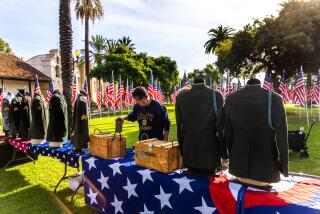Veterans of Both World Wars Marching Toward a Memorial to Military Women
- Share via
WASHINGTON — When Mary Hoffman joined the Army during World War II, she was a serious young woman who thought she had already missed her chance to have a full life. But the Women’s Auxiliary Army Corps changed that.
“I thought I was going to be a spinster,” she recalled 47 years later. “Instead, I married my first bedside patient.”
Hoffman is one of the 350,000 women who served in World War II. She is also the largest single donor to the foundation promoting a memorial to women veterans. She has given more than $60,000 to the project, all from disability pay received after breast cancer forced her to leave the service in 1945.
Now 83 and widowed, Hoffman said from her home in Hyattsville, Md., that there are so many monuments and memorials to men who served, but “(women) are the last group to unite. I do feel it’s so well worth it.”
As an occupational therapist in the Women’s Air Corps at Woodrow Wilson Hospital in Staunton, Va., she taught injured soldiers to make wallets or belts, to type or to knit.
“I didn’t have a sense of humor when I first went into the military,” she said. “I was a little old-fashioned, wearing my hair up. But the Army made me over, believe me.”
Hoffman’s story is one of about 50,000 collected so far for a museum that will be part of the memorial, Wilma Vaught, the retired Air Force brigadier general who heads the Women in the Military Service of America Foundation.
Vaught said she is delighted with Hoffman’s generosity, but she needs $25 million for the memorial and is $22.5 million short of that goal.
“There are over 1.2 million living women veterans and 400,000 women on active duty and in the Guard and reserves” who are potential donors, Vaught said in a recent interview at the foundation’s office in Arlington, Va.
Part of the fund-raising problem, Vaught said, is finding those women, as well as descendants of American women who served in wars since the Revolution--as nurses, scouts, suppliers, soldiers and saboteurs.
Privacy laws keep Vaught from drawing up mailing lists from government rolls, so she has been relying on the detective work of about 450 volunteers to find these women.
The fund drive had a setback this year. When the foundation tried to raffle a $1-million house in suburban Centreville, Va., ticket sales were disappointing.
“We saw this as a mechanism that, in a really short period, we could raise a lot of money,” Vaught said, but the timing of the event was unfortunate and D.C. Mayor Marion Barry’s trial on cocaine charges distracted media attention.
As the date for the drawing approached in early November, only about 24,000 of 1 million raffle tickets had been sold and Vaught was forced to postpone the drawing until next Feb. 23.
There has been progress on the project, however. A site has been chosen near the ceremonial entrance to Arlington National Cemetery and the foundation last year chose a design submitted by New York architects Marion G. Weiss and Michael Manfredi.
More to Read
Sign up for Essential California
The most important California stories and recommendations in your inbox every morning.
You may occasionally receive promotional content from the Los Angeles Times.










